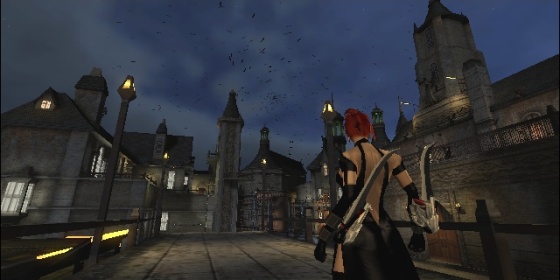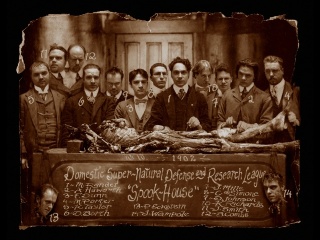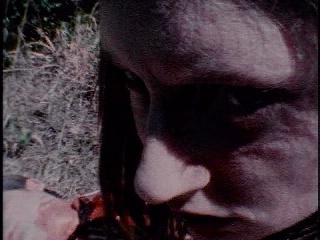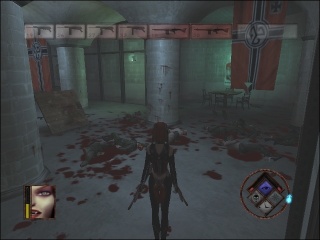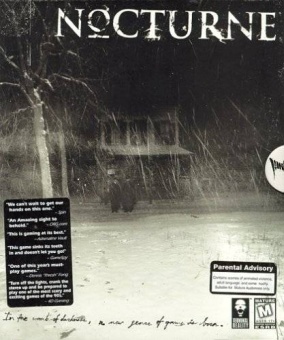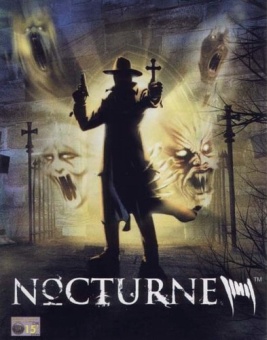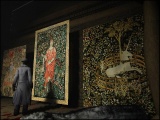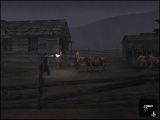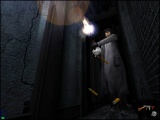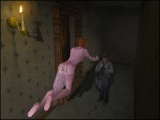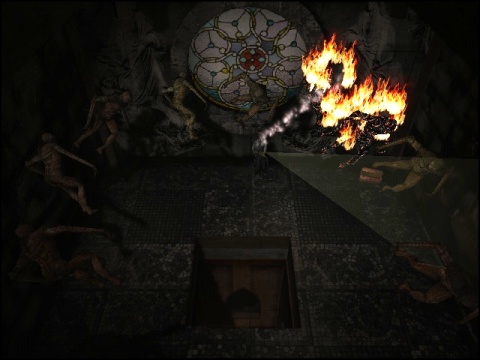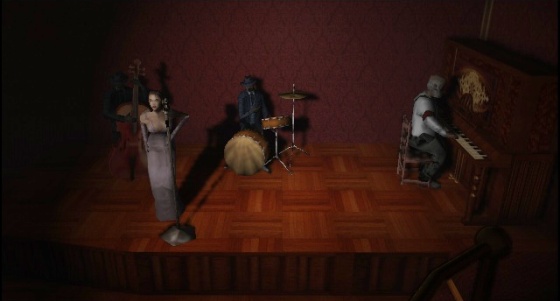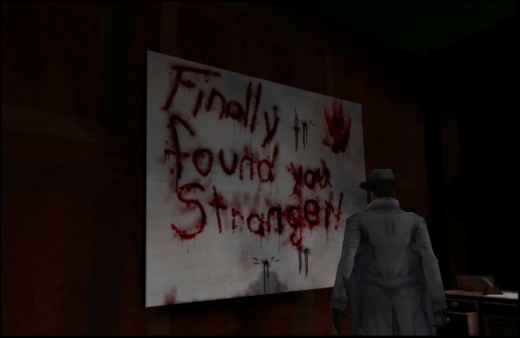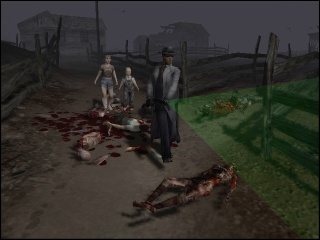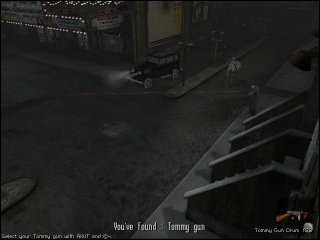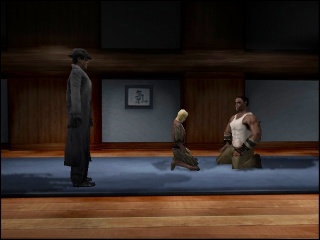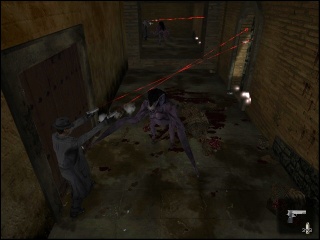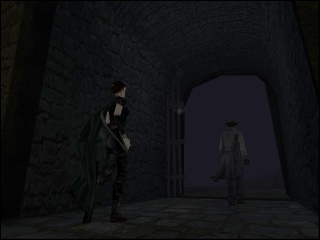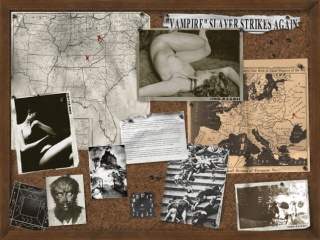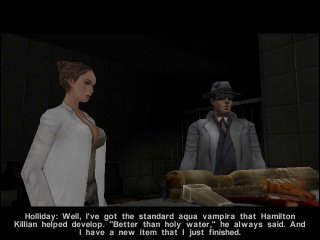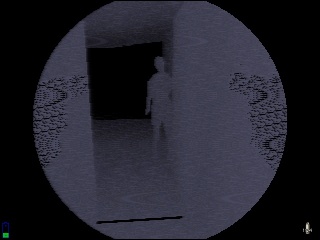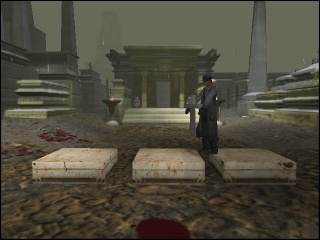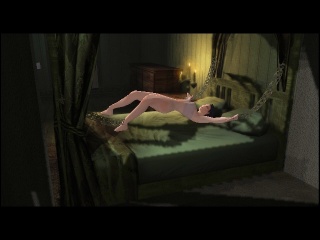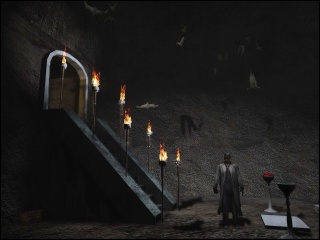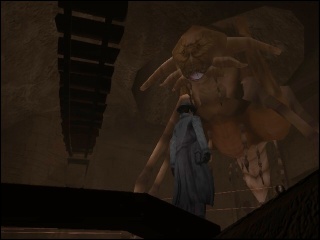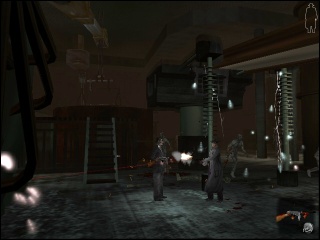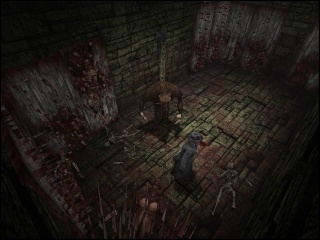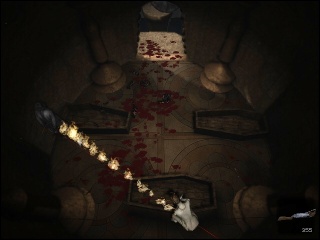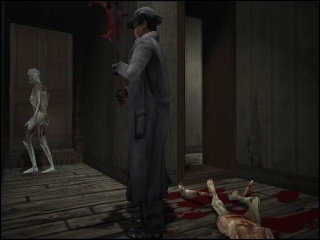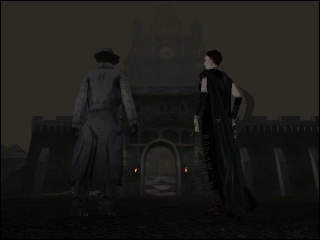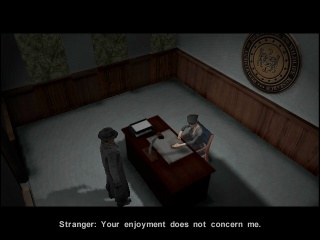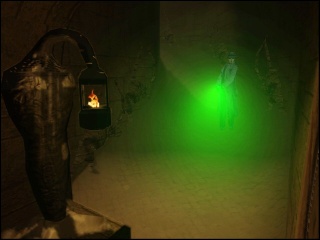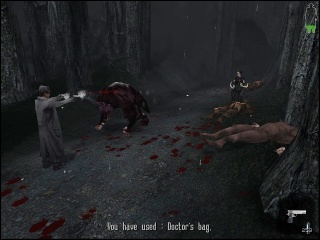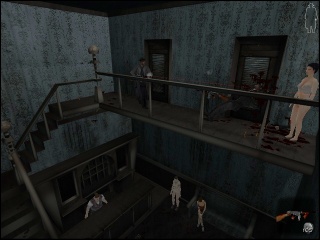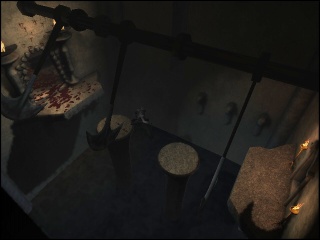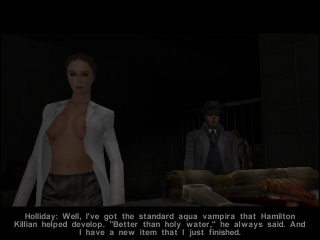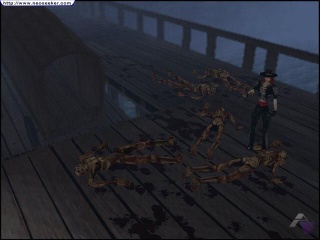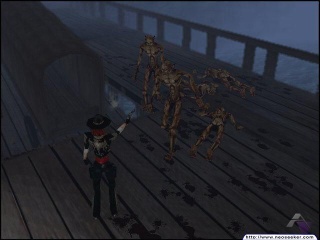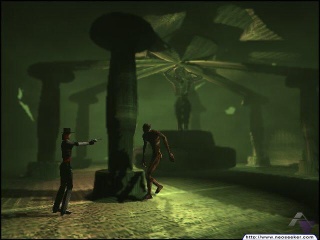
Terminal Reality Horror Games
|
<<< Prior Page |
|
Page 1: |
Page 2: |
Page 3: |
Page 4: |
Page 5: |
|
Page 6: |
Page 7: |
The world is a dark place.
Who will protect the world from darkness?
We will... after we play our stupid games.
Horror is a very particular genre throughout all media. Nowhere else is being rough around the edges as much a virtue as it is here, the same goes for being high gloss trash. Fanservice and crossover have also been staples in the genre decades before the terms got even invented. Vampires vs Werewolfs are a horse beaten to death more than most other clichés now, but ever since Frankenstein met the Wolf Man in Universal Studio's 1943 classic, horror fans knew that two monsters are better than one. Fast forward 45 years, small but renowned developer Terminal Reality, Inc. is working on their ultimate monster mash, as deeply in love with classical horror cinema as it is with 1930s pulp fiction.
Terminal Reality's history is one of the more colorful among american developing houses. Founded by ex-Microsoft employee and Flight Simulator programmer Mark Randel, the company originally came to fame for some of the best flight sim/action games of their time, although they produced just as many racing games, too. After cooperating with Microsoft for the first couple of years, TR became one of the founding members of the Gathering of Developers, short GOD, to make the games they want under their terms, independent of big publishers.
GOD's dazzling light shone bright but briefly, and after the Gathering broke apart and was bought out by Take-Two, Terminal Reality partnered up with Majesco. This alliance brought about the biggest success until then for both with the Bloodrayne franchise. But it shouldn't last too long, either, before mismanagement drove Majesco into financial trouble, making the company incapable to handle the kind of full-priced hardcore game titles Terminal Reality used to make, retreating back to the handheld and casual market. After keeping themselves afloat for years with localization of SNKP compilations of NeoGeo games, Terminal Reality managed to win back the spotlight with another vaguely horror-themed title, the long awaited sequel to Harold Ramis' and Dan Akroyd's Ghostbusters movies in video game form.
TR have always been a very versatile developer - their latest game is the "rap simulation" Def Jam Rapstar - but the most peculiar and memorable titles in their portfolio have always been their various horror games. The deft use and combination of clichés, going so far as to release each game either on or close to Halloween, makes them the games that come closest to the B-movie and (in the case of Nocturne) pulp novel spirit they're trying to emulate, even more so than the incomparably more popular Resident Evil series (which seems to have shed that image long since, too).
Bloodrayne 2 (XBox)
Sources and Links:
- Terminal Reality official homepage
- BloodRayne official homepage (archived in the Wayback Machine)
- BloodRayne official Japanese homepage
- BloodRayne 2 official homepage (archived in the Wayback Machine)
- BloodRayne franchise homepage
- Joe Wampole Jing's homepage (archived in the Wayback Machine)
- Nocturne interview at FiringSquad; August 18, 1999; with Mark Randel (archived in the Wayback Machine)
- Nocturne interview at Just Adventure; with Jeff Mills and Drew Haworth (archived in the Wayback Machine)
- Blair Witch Vol. 1 interview at loonygames; February 22, 2000; with Jeff Mills and Jeff Smith (archived in the Wayback Machine)
- Visiting Terminal Reality at FlightSim.com; around the time of the release of Fly!
- BloodRayne interview at HomeLAN; January 9, 2002; with Jeff Mills, Frederick Jones, Joe Wampole and Fletcher Dunn (archived in the Wayback Machine)
- BloodRayne 2 interview at IGN; February 14, 2004; with Liz Buckley (archived in the Wayback Machine)
- BloodRayne 2 video interview at Gamespot; August 24, 2004; with Drew Haworth
- Ghostbusters interview at Strategy Informer; with Brendan Goss and Drew Haworth
- BloodRayne 2 FSAA Patch by mctronken
(Notice: To improve visibility of the screenshot thumbnails, they've been brightened up in post-processing by a significant amount. The actual game is a lot darker. Klick on the images to see them with their original brightness values.)
The background story of Nocturne is as decidedly kitsch as they ever get. Set in the 1920s and 1930s - not by accident the golden age of pulp magazines - the game depicts the work of the Spookhouse, a secret government organization founded by Theodore Roosevelt after he killed a werewolf during the Spanish-American war in Cuba in 1898. Originally created to wipe out monstrous creatures in so-called horucide projects, this world police of the supernatural had become almost more of a monster squad over the years. This makes for a very colorful cast of characters, for most of which the game unfortunately doesn't have the time to flesh them out very well.
Active Spookhouse Agents
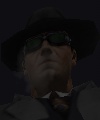
The Stranger
The man only known as The Stranger is the mysterious protagonist of Nocturne. With his fedora and trenchcoat, also dual-wielding a set of pistols, he is clearly reminiscent of The Shadow from the 1930s pulp magazine serials, radio plays, comics, and movies. No one knows where he comes from or what his true name is (although the voice actor credits list him as "Joshua Stranger"). It appears, however, that the hunt is personal to him, as his spite towards monsters goes beyond what is to expected. Voiced by Lynn Mathis (†2003).
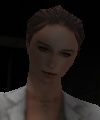
Elspeth "Doc" Holliday
The "Q" of the Spookhouse, Doc Holliday is a technician who comes up with ever new inventions to properly dispose of all kinds of monstrosities. Her laboratory contains a computer vaguely resembling an ENIAC - only about 20 years before that machine was actually invented. When she goes on field missions, her approach is more investigative compared to many of her more rough colleagues, making her the ideal agent to deal with the Rustin Parr case in the Blair Witch game. Voiced by Candace Evans.
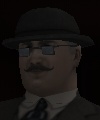
Hiram Mottra
A psychic, Hiram cannot actually read thoughts, but has a supernatural sense for danger, or more precisely hostile intentions geared towards himself. At least that's what he claims, while many of his acquaintances dismiss his "premonitions" as simple paranoia. Voiced by John Galt.
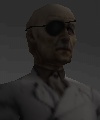
Colonel Cedric Feldspar Hapscomb
Colonel Hapscomb is the current head of field operations at Spookhouse. He was stationed as a military officer in Bombay in the final years of british rule, but fatally wounded during a rebellion. Revived through the supernatural ways of native Thuggees, he noneteless ended up listed as deceased by the British, leaving him free to become a great hunter in the wilderness, until he joined the spookhouse to hunt even more dangerous beasts. He of course has his roots in the great fictional adventure heroes of colonial times like Allan Quatermain, though we never see him in action during the course of the game. Voiced by Brazos Mcdonald (Ric Spiegel in Blair Witch Volume One).
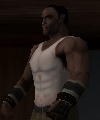
Sammy "Haystack" Kayo
The least fleshed-out character in the game itself, yet his background story from the manual might be one of the most interesting. After his boxing career was ended by the influence of supernatural powers, he joined a wandering circus, where he learned from gypsies to link his boxing style with magic and in turn took a vampire lord in a fistfight for them, who unfortunately managed to escape and swear revenge on Haystack. In the game, the boxer comes off as a kind simpleton, who one would never have cared about without that background story, as he's only ever seen training with Moloch in the spookhouse headquarters. Voiced by Dell Johnson.
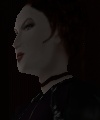
Svetlana Lupescu
Svetlana was born in Romania from the union of a vampire father with a human mother, making her a half-vampire, dhampir. Shunned by her deceased mother's human family, she was brought to the spookhouse at the age of ten, where she was raised to become an agent to hunt the vampires her human side so loathed for the fate given to her. Voiced by Candace Evans in a Bela Lugosi imitation.
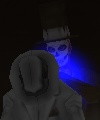
Scat Dazzle
Scat grew up in Louisiana, where he was brought up to become a mighty voodoo priest. Because of his love for jazz, he ran away to New Orleans, where he became one of the finest trumpeters around. On his 18th birthday, however, the mighty Loa of death, Baron Samedi, seized control over his body, burning the club Scat was currently performing to the ground. The mannerless deity made the musician his occasional slave for years, until Scat learned to retain control over his body and in turn gained some ability to exert power over Baron Samedi himself. As Samedi is immortal, Scat can also be revived from death by summoning the Baron. Also voiced by John Galt. (Baron Samedy voice by Lynn Mathis.)
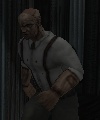
Vincenco "Icepick" Gasparro
Icepick was one of the first dead mobsters to be revived by Al Capone and the crazy German scientist Loathring. Other than most of the other frankenmobsters he refused to accept his fate and called in Spookhouse, providing them with information and directly aiding The Stranger on his mission in Chicago. Afterwards he joined Spookhouse as a full agent. His background in the manual is contradicting with the game, though. The manual tells he was found and healed by Doc Holliday and joined spookhouse out of gratitude towards her. In the game, however, he is introduced as an anonymous informant until The Stranger meets him in Chicago, much to the surprise of the monster-hating anti hero. Voiced by Jeremy Schwartz.
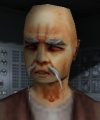
Khen Rigzin
The old Tibetan monk plays his role as the Mister Miyagi-type wise martial arts mentor of Nocturne. Although he is still deadly in a fight despite his old age, he mostly resides at the spookhouse headquarters, responsible for the physical and spiritual traning of the other agents. Another one voiced by John Galt (Dameon Clarke in Blair Witch Volume One).
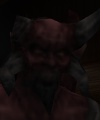
Moloch
After being cast out of hell by his kind, Moloch betrayed the underworld to the Spookhouse and helped them to seal a door to hell in the Nepalese mountains. He became an invaluable member to Spookhouse, providing them with countless information about the underworld. Yet as the first of many monstrous agents Spookhouse took in, he repelled many of the more conservative members, most notably Hamilton Killian, who until then had been the agency's top monster hunter. Voiced by John Galt.
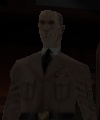
General Seymore Biggs
A friend of Colonel Hapscomb who joined Spookhouse in 1933 to serve as a cover with his troops for the bigger domestic Spookhouse operations. Another role voiced by Jeremy Schwartz (Sean Hedigan in Blair Witch Volume One).
Of course when adhering to such aged and decidedly low-end stylistic and aesthetic conventions, one shouldn't make the mistake to take oneself all too seriously. A healthy portion of self-humor is necessary to make it all work, and Nocturne performs it ever so subtly. This subtelty helps the game to always stay in character, without succumbing to a spoof of itself. Everything fits in perfectly, from the extremely campy live-action trailers and intro, up to fine jokes like Stranger's reluctance to say the silly Spookhouse password, which itself sounds like an hommage to the opening words of each radio episode of The Shadow. (Who knows what evil lurks in the hearts of men? The Shadow knows!)
Speaking of episodes, Nocturne also doesn't tell one single continuous tale, but is divided into several cases for Spookhouse over the years, following the serialized nature of the pulp magazines. Over the course of the game, The Stranger engages in four such missions.
The Assignments
Act I (Germany, 1927)
Dark Reign of the Vampire King
A remote village in Germany reports repeated sightings of vampires, werewolves and other monsters. Spookhouse suspects the nearby castle Gaustadt to be the hiding place of the Yathfoe-Gyoule stone, a powerful artifact that can rid any vampire who wields it from its natural weaknesses, making it practically invincible. The Stranger and Svetlana are sent to the area to find and retreive the dangerous stone.
Act II (Texas, 1931)
Tomb of the Underground God
In this case The Stranger and Hiram Mottra take the train to a town in Texas, where the dead have rosen from their graves. Even before reaching the town, the two agents are attacked by Werewolves, survivors of a past horucide. The town itself is no less trouble, Stranger finds only the corpse of Scat Dazzle, whom he was supposed to meet there. It turns out the walking dead are only a symptom of a much greater evil that lurks in the mines below.
Act III (Chicago, 1933)
Windy City Massacre
Al Capone is terrorizing Chicago with an army of undead mobsters. An all-out combat mission where Stranger not only has to fight a guerilla war against legions of frankenmobsters from hideouts in the back alleys of the capital of organized crime, but also destroy the mad scientist's factory with the help of informant Icepick.
Act IV (France, 1935)
The House on the Edge of Hell
Hamilton Killian used to be a Spookhouse agent until he became instable after the death of his wife and left the agency not quite voluntarily when it started to accept monsters into its ranks. Now he calls on the Spookhouse for help with paranormal activities around his mansion. Stranger takes on the seemingly harmless mission alone, but soon finds himself inside of a sadistic deathtrap.
At first glance, Nocturne could be mistaken for a blunt Resident Evil clone. When looking deeper, however, the similarities don't go much farther than both games being action adventure games with cinematic, fixed camera angles and a horror scenario. Whereas other games in the genre that has become known as survival horror almost invariably feel stiff with cumbersome fighting, Nocturne controls surprisingly flexible. The Stranger can jump, strafe and run while shooting (things that to this day seem to be problematic for the Resident Evil series). The standard control scheme in fact doesn't differ much from your average FPS.
Unfortunately, the changing perspectives don't lend itself too well to this style of play, it's easy to get confused with directions and one definitely wants to keep manual aim switched off most of the time, as hitting something on purpose is nigh impossible from more artistic camera angles. The auto aim works really well, though, but it won't help either when facing the completely wrong direction by accident. Scene transitions also come sometimes quite abprupt and unexpected. Those unfortunate enough to be caught in a tight spot in battle just around a point that triggers a scene transition can consider themselves as good as dead.
The guys a Terminal Reality well knew of the problems of fixed camera angles, and offer a remedy for situations like that, albeit a temporary and somewhat unreliable one. Among the gadgets The Stranger gets from Doc Holliday is a prototype night vision device, that allows for exploration and combat in first person perspective. The areas are fully modeled in 3d, but not textured, which is excused by the somewhat impaired vision that naturally comes with such devices. Of course its use is also limited to darker areas, but worse is the battery, which lasts no longer than a few seconds at a time before it needs to recharge.
The doc also has more martialistic gear to offer. Her newest death-dealer is the "Sun of God", which causes a beam of light almost as bright as sunrays. While most creatures are merely blinded by the weapon, it means instant death to vampires. Most of the time The Stranger relies on his standard dual guns, preferably loaded with silver bullets. Their biggest draw is the ability to aim at two different enemies at the same time. Even if they take a lot of time to kill stronger enemies, this helps to keep them at bay until they finally succumb to the continued shelling. A crossbow is indispensable, too, and the Stranger can also use whatever weaponry he may find during a mission to maltreat his enemies with, from an axe to a tommy gun.
The Stranger is not above burning vampires in their sleep
Although the amount of action is more than most comparable games in the genre, the "adventure" element isn't neglected, either. The distribution between both aspects differs between episodes, but even the most action-oriented parts break up every once in a while to demand a more conciderate approach to some problems. Most puzzles are integrated logically into the mission. In act II for example, the Stranger has to escort the survivors in the zombie-infested town to the church to get the time to question them and maybe find out more about the origin of the catastrophe. Later on, Stranger sends a box of dynamite through a mining lift to detonate it and open up a blocked up passage. All too constructed puzzles about chess figures, exploding floor tiles and complex lever games are reserved for the last mission, as that takes place in a single huge death trap labyrinth for the creatures of the night.
Terminal Reality has always been partly a technology company that spends as much effort on a solid and impressive programming fundament as on game design and scenario. Their Infernal Engine nowadays is one of the most widely licensed professional graphics & physics engine. Nocturne's engine is in many ways its spiritual antecede. When the game was first presented, it bedazzled most onlookers with its elaborate cloth animations, but even more impressive from a technical standpoint was the dynamic lighting with realtime shadows cast from multiple light sources. Mirror effects weren't a matter of course yet, either. The mostly dark backgrounds themselves were standard fare for late '90s renderings, but the way the effects helped to merge them together with characters into a coherent whole hadn't been seen in that quality before.
German Fun Fact #1
Terminal Reality isn't really connected to Germany in any way, except for their games occasionally taking place there. Yet they always had a peculiar standing in that country due to contents that would make any rating board cringe - violence, sex, Nazis... there's plenty of incentives for a rigid government to have that stuff banned. Surprisingly enough, Nocturne got away with a 16-and-up rating without having to make any compromises concerning the gore or nudity.
There was, however, another issue that caused a headache for the publisher - The first episode takes place in and around a fictional German castle called Gaustadt. A Gau used to be a regional administrative unit during the Third Reich. As a matter of fact, the term has been in use for centuries before the Nazis, and even today it is part of several real place names. Nonetheless, it seemingly was too dicey a name for the dreck medium that video games used to be in the eyes of the government, thus the castle was renamed to Naustadt.
More eye-catching than the lighting in this respect are the blood splatters that are soon spilt all over the place when Stranger meets with a pack of werewolves or a horde of zombies. Nocturne is a truly gruesome game, with monsters throwing the severed limbs of their fallen fellows at the player and flies praying on the hacked remains. Characters are burned alive, a fate most cringeworthy when it happens to the Stranger: The flames slowly burn him into a lump of coal, without anything one can do about it. He shows no signs of pain and can continue to run around and ignite monsters, until the flames consume him whole. Creepy stuff.
But Nocturne not only excelled in terms of violent content, also the handling of sexual themes set a new benchmark, at least for commercially published American games. After all, Nocturne was one of the games published through GoD, the then famous-infamous mavericks of the video game industry. Equally explicit uncensored texturing is nothing we'll see much in any games published after the demise of that alliance. It certainly can be argued that this amount of detail is unnecessary, but it appears never out of place when Stranger seeks refuge from chicago mobs inside of a bordello or is seduced by a succubus. After all, horror and eroticism always maintain a strange and grotesque symbiosis, just ask Jonathan Harker what happened in Dracula's castle when the count wasn't at home.
To a truly cinematic presentation also belongs an adequate voice-over, and this is another point where Nocturne succeeds. Lynn Mathis as The Stranger delivers the perfect cynical, laid-back anti-hero performance, and the supporting cast is well complemented by their voices, too, taking their roles just with the necessary amount of fake seriousness. Hiram Mottra sounds as paranoid as any sane person would see someone who constantly claims he's sensing malevolence towards his person in others, Candace Evans as Svetlana Lupescu delivers an almost convincing Bela Lugosi-imitation, while in the role of Elspeth Holliday she's the typical well-educated upper class lady.
The cutscene choreography didn't age quite as well. Special animations are sparse and don't look all that natural, but worst of all the sequences are quite glitchy. All are realized in-engine, and elements are subject to the same rules as they are during regular play. Mostly complications only result in some awkward setups, but in a worst case example characters can get stuck in the scenery indefinitely, forcing one to skip the cutscene, which fortunately is always an option. There is even one particular cutscene where that glitch occurs regularly, making it impossible to watch through the whole scene.
Enjoy 'em while you can, it's their last performance
Aside from slightly problematic controls and a number of glitches, Nocturne is almost a perfect game in its chosen subgenre. The characters are designed over the top just so much to give the game a note of humour without ridiculing themselves, the level design feels very authentic for the individual locations and the action is always challenging but rarely frustrating (at least with activated auto aim). Especially the last mission is designed as an extraordinarily intense and deadly experience with tricky puzzles one can actually get stuck at for a while, something the "adventure elements" of the perceived main competitor Resident Evil never achieved. Survival horror fans seeking to test their skills, this is just the game for you.
And if that wasn't enough, players could always design their own missions, worlds and characters in the Nocturne engine, provided solid technical skills and a copy of 3D Studio Max. Half-Life had only just begun to make modding en-vogue when TRI released their editing tools for the game, and it had previously almost always been the domain of the FPS genre. In consequence, the progressive step didn't bear much fruit, but there have been at least 4 custom missions created by one "Agent Heretic", as attested on an archived 3D Action Planet fan site, which now seem to have been lost forever.
Nocturne closed the curtains over a particularly grim cliffhanger, but fans are still forced to wait for a conclusion. Not too long after the game's release, Terminal Reality started working out a concept for a direct sequel. The Gathering of Developers began to collapse around that time, though, and TR were forced to look for a corporate publisher to deal with. Not willing to give up the rights to Nocturne, the Spookhouse and the whole setting to someone they didn't trust, the team shifted their plans to create some kind of spin-off franchise instead, taking many of the elements already fleshed out for Nocturne 2 but changing the main characters and brand name - the concept for BloodRayne was born.
To be continued? Maybe not ...
Quick Info:
|
Developer: |
|
|
Publisher: |
|
|
Designer: |
|
|
Genre: |
|
|
Themes: |
Nocturne
Nocturne
Nocturne
Nocturne
Nocturne
Nocturne
Nocturne
Nocturne
Nocturne
Nocturne
Nocturne
Nocturne
Nocturne
Nocturne
Nocturne
Nocturne
Nocturne
Nocturne
Nocturne
Nocturne
Nocturne
Nocturne
Removed Content
Nocturne's manual mentions three more Spookhouse agents that don't appear anywhere in the game: Gabriella Augustini, Kariker Thompson and Rogan Parthaswanu. The former was planned as an alternative playable character, and indeed first screenshots of the game prior to release showed a female protagonist in a Western style attire, fighting monsters in locations that are not seen in the final game, either. The game archives also contain files for her model, and by changing a parameter she can be used to replace Stranger, but she is quite unfinished and most maps will just crash when started with her. (Images snatched from a site that doesn't have the decency to spare their screenshots ugly watermarks, which it seems snatched them from another site that didn't have the decency to spare their screenshots ugly watermarks. Sorry!)
Kariker Thompson meanwhile appears as missing in action on the agency's MIA/KIA blackboard, on the side of many other unknown agents that are not so much as mentioned in the manual. Towards Rogan there are no hints to be found at all in Nocturne, only in Blair Witch Volume One he appears on the wall as to have been either killed or disappeared in 1935, together with Haystack, Icepick and Moloch. Joe W. Jing remembers, "there was something we referred to as the Horucide that we had written up as backstory and potential for other missions as Nocturne's story didn't absolutely have to be sequential. I think the premise was there was a breach from hell that Spookhouse had to contend with and, if I'm not mistaken, I think Rogan bit it there. Demons." Some of the remaining agents were obviously also intended for expanded roles, given their expansive backstories in comparison to very short screen time. Trailers of the game showed at least Haystack in action during one of the missions.
On another note, the game files also contain an alternative model for Doc Holliday, leaving her almost topless when switched with the original one. One would think there'd be some kind of code to access it legitimately through the game itself without meddling with the files. It's not like it could make the game any more immoral than it already is, after all. Yet no such code is known.
Sketches from the Manual
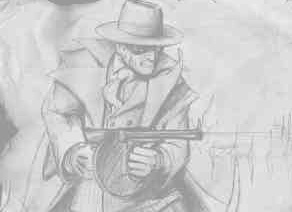
The Stranger
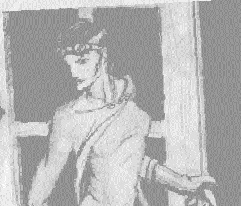
Doc Holliday
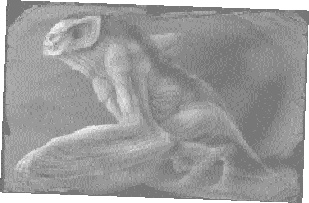
Vampire Beast
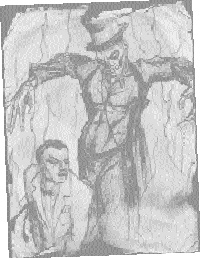
Scat Dazzle / Baron Samedi
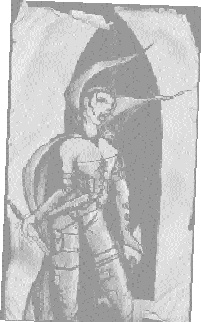
Svetlana
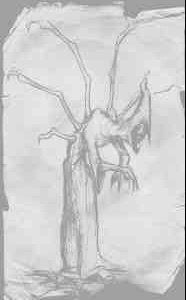
Priest of Gardath
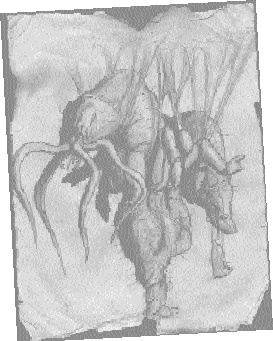
Elder God
|
<<< Prior Page |
|
Page 1: |
Page 2: |
Page 3: |
Page 4: |
Page 5: |
|
Page 6: |
Page 7: |
